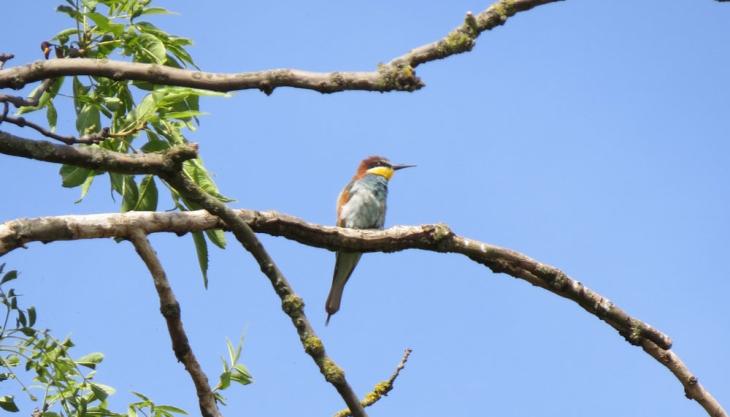Bee-eater chicks hatch at East Leake Quarry

Rare visitors to the UK being given round-the-clock protection at a Nottinghamshire quarry
BEE-eater chicks have hatched at CEMEX’s East Leake Quarry in Nottinghamshire – just the third time such an event has happened in the UK in a decade.
Seven rare bee-eaters, a spectacularly colourful bird which usually breeds in southern Europe and Africa, turned up unexpectedly at the quarry near Loughborough on 25 June. Three nest holes have been seen in the quarry’s sandy bank.
Earlier this week, RSPB wardens watching the nests noticed parent birds flying to and from one of the nest holes with food, indicating that young were being fed, and all three nests are expected to have young by this weekend.
Already, around 10,000 people are thought to have seen the Nottinghamshire bee-eaters, some travelling from as far afield as Cornwall and Co. Durham.
As their name suggests, bee-eaters feed predominately on bees and other flying insects such as wasps and dragonflies. After catching a bee, the birds will toss it into the air or strike the bee against a branch to remove the string, rendering it safe to swallow.
Mark Thomas, the RSPB’s senior investigations officer, said: ‘Bee-eaters are sociable birds and nest together in small groups. Often pairs will enlist the help of a single, younger bird to help bring food and rear their chicks. Bringing up baby is very much a community effort.’
Because the birds are so rare, round-the-clock protection was necessary to ensure the birds and their nests were not disturbed. Working closely with CEMEX, the RSPB deployed wardens to monitor the site day and night to ensure the safety of both birds and birdwatchers.
Mr Thomas explained: ‘By day, the nests were at risk from egg collectors, and by night the eggs – and now the chicks – are at risk of being taken by a fox. Fox prints were seen in the sand, so we posted wardens armed with torches on night watch to deter any predators that might be on the prowl.
‘Sure enough, one night, a fox appeared near the nests, but was scared away by the torchlight. If we hadn’t been present, it would almost certainly have got the chicks.’
Andy Spencer, sustainability director at CEMEX, said: ‘Working quarries like this one offer the perfect home for bee-eaters and other birds like sand martins. At CEMEX quarry sites we build dedicated sand piles away from the operations where birds can make their nests and breed without interruption. We’re delighted to be hosting these charming visitors for the duration of their stay in the UK.’
The bee-eater nestlings are expected to fledge around mid-August, giving birdwatchers a chance to see them before the colony flies back to its southern territories.









